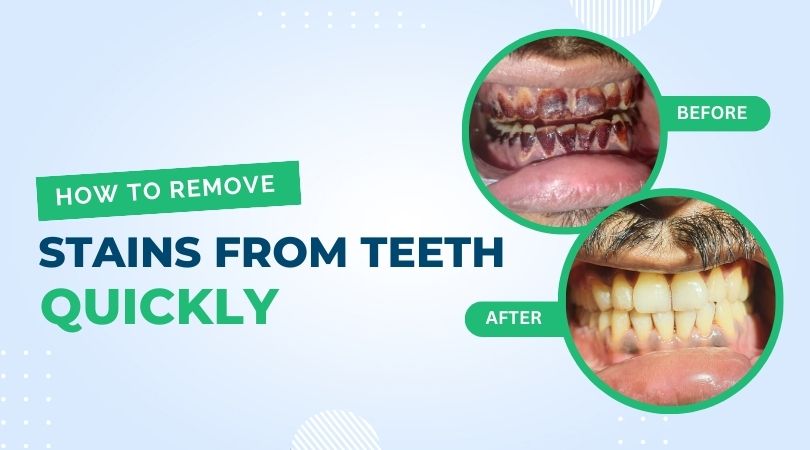
A dazzling smile can significantly boost your confidence and leave a lasting impression on others. However, maintaining pristine white teeth can be challenging, especially when confronted with common culprits of teeth staining like coffee, tea, red wine, or tobacco use. In such cases, relying on dental treatments becomes a necessity.
At Teeth Care Multispeciality Dental Clinic, we understand the importance of a bright smile, and we're here to guide you through effective dental treatments that can remove stains from your teeth quickly.
Professional teeth cleaning, typically performed by a dentist at our clinic, offers numerous benefits beyond the regular brushing and flossing routine. These benefits include:
During a professional cleaning, the dentist uses specialized tools to remove plaque and tartar from your teeth. They also polish the teeth, leaving them sparkling clean and stain-free.
The frequency of professional cleanings depends on individual needs. Most people benefit from biannual cleanings, while others may require more frequent visits based on their oral health.
There are various teeth whitening treatments available at our dental clinic. The dentist analyzes your teeth and accordingly prescribes the treatment to whiten your teeth. The typical teeth whitening treatment is Laser Teeth Whitening.
Teeth whitening is a quick and effective solution for removing teeth stains. This treatment involves the application of a whitening gel and the use of a special light to activate the gel. Benefits include:
Some other teeth whitening options available are:
Dental veneers are thin, custom-made shells typically made of porcelain or composite resin that are designed to cover the front surface of a tooth. They provide an effective solution for removing deep-seated stains and discoloration. They are used in cosmetic dentistry to enhance the appearance of teeth, especially in cases where teeth are discolored, stained, misaligned, chipped, or have other aesthetic imperfections. Dental veneers are an effective and minimally invasive way to improve the overall look of a smile.
Veneers mask stains by covering the tooth's surface, providing a flawless appearance.
The veneer application process involves preparing the teeth, taking impressions, and bonding the veneers in place. Veneers offer long-lasting stain removal.
Veneers can last many years with proper care, including regular oral hygiene and avoiding excessive force on your teeth.
Dental bonding, also known as tooth bonding or dental composite bonding, is a cosmetic procedure in which a tooth-colored resin material is applied to stained teeth and then hardened with a special light. It is a cosmetic dental procedure that involves the application of a tooth-colored resin material to repair or improve the appearance of teeth. Dental bonding is a versatile and minimally invasive treatment option used to address various dental issues.
Bonding is an effective method for removing superficial stains and repairing minor dental imperfections.
The bonding process is straightforward and typically takes just one dental visit.
Pros of bonding include affordability and quick results, but it may not be as long-lasting as other treatment options like veneers.
Dental crowns, or caps, are used to cover the entire tooth and are often recommended when other stain removal methods are not effective. It helps in restoring its shape, size, strength, and appearance. Crowns are commonly used in dentistry to address various dental issues and provide both functional and aesthetic improvements.
Crowns are ideal for teeth with extensive damage or deep discoloration that cannot be treated by other means.
Crown placement involves tooth preparation, taking impressions, and fitting a custom-made crown.
Dental crowns require regular care, similar to your natural teeth, to maintain their appearance and function.
Scaling and root planing (SRP) is a dental procedure primarily used to treat gum disease (periodontal disease) by removing plaque and tartar buildup on the teeth and the roots of the teeth. While SRP is primarily aimed at addressing gum health, it can also contribute to stain removal as a secondary benefit.
This deep cleaning procedure involves the removal of tartar and bacteria from the tooth's root surfaces.
Following scaling and root planing, maintaining proper oral hygiene and regular dental check-ups are crucial for preventing future staining.
Maintaining a stain-free smile after undergoing dental treatments for stain removal is crucial for preserving the results of the procedures and ensuring long-term oral health. Diet and lifestyle changes play a significant role in achieving and sustaining a bright, stain-free smile. Here are some important diet and lifestyle changes to consider:
By making these diet and lifestyle changes, you can enjoy a bright, stain-free smile and promote your overall oral health. Remember that consistent, proactive measures are key to preserving the results of your dental treatments for stain removal.
Dental stain removal treatments can benefit a wide range of individuals who are looking to improve the appearance of their teeth and achieve a brighter, stain-free smile. These treatments are suitable for people who have various types of tooth stains, discoloration, or other cosmetic concerns related to the color of their teeth. Here's a breakdown of who can benefit from dental stain removal treatments:
If you're unhappy with the appearance of your stained teeth, it's advisable to consult a dentist for a professional assessment and personalized treatment plan.
Conclusion
A radiant, stain-free smile is within reach, thanks to the array of dental treatments available at Teeth Care Multispeciality Dental Clinic. Choosing the right treatment option depends on the severity of your stains and your personal preferences. Remember that maintaining a dazzling smile is an ongoing commitment that requires regular dental visits and a focus on oral hygiene.
Ready to take the first step towards a brighter, stain-free smile? Schedule a consultation with our expert team at Teeth Care Multispeciality Dental Clinic today. We're here to provide the best solutions to enhance your smile and boost your confidence. For more information and to book your appointment, contact us.